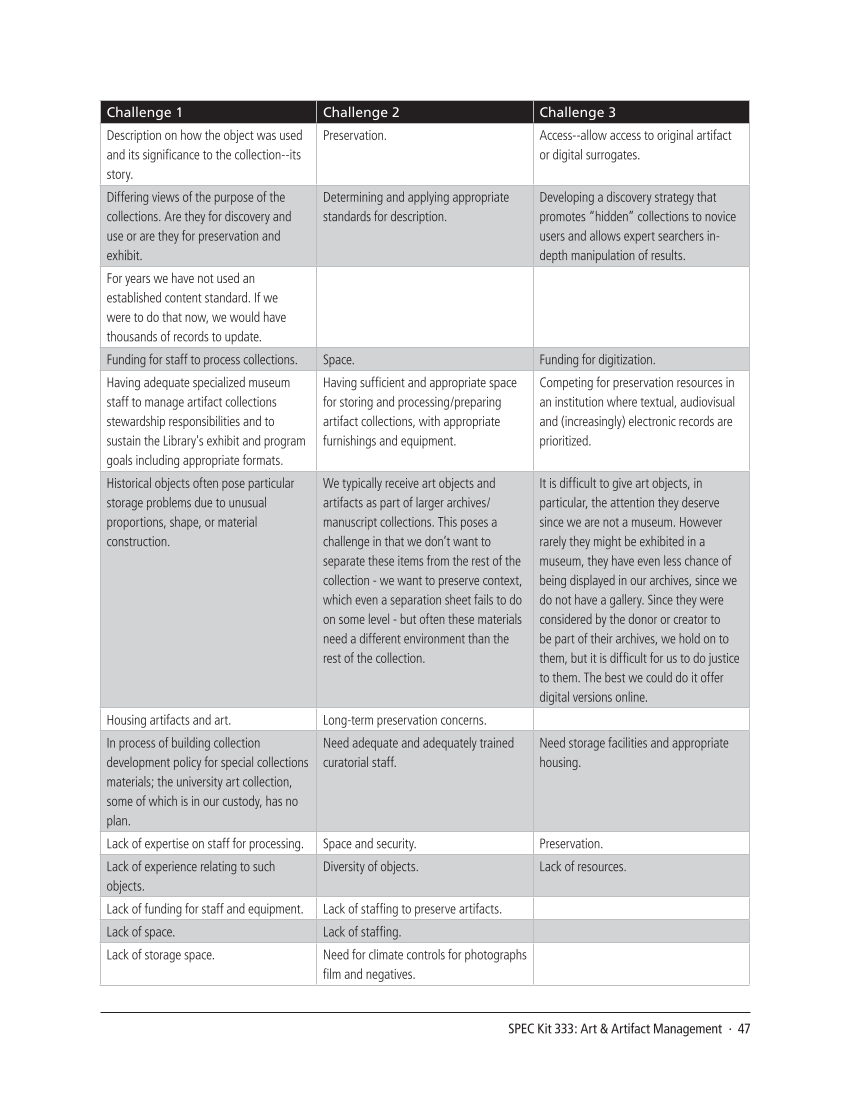SPEC Kit 333: Art &Artifact Management · 47
Challenge 1 Challenge 2 Challenge 3
Description on how the object was used
and its significance to the collection--its
story.
Preservation. Access--allow access to original artifact
or digital surrogates.
Differing views of the purpose of the
collections. Are they for discovery and
use or are they for preservation and
exhibit.
Determining and applying appropriate
standards for description.
Developing a discovery strategy that
promotes “hidden” collections to novice
users and allows expert searchers in-
depth manipulation of results.
For years we have not used an
established content standard. If we
were to do that now, we would have
thousands of records to update.
Funding for staff to process collections. Space. Funding for digitization.
Having adequate specialized museum
staff to manage artifact collections
stewardship responsibilities and to
sustain the Library's exhibit and program
goals including appropriate formats.
Having sufficient and appropriate space
for storing and processing/preparing
artifact collections, with appropriate
furnishings and equipment.
Competing for preservation resources in
an institution where textual, audiovisual
and (increasingly) electronic records are
prioritized.
Historical objects often pose particular
storage problems due to unusual
proportions, shape, or material
construction.
We typically receive art objects and
artifacts as part of larger archives/
manuscript collections. This poses a
challenge in that we don’t want to
separate these items from the rest of the
collection -we want to preserve context,
which even a separation sheet fails to do
on some level -but often these materials
need a different environment than the
rest of the collection.
It is difficult to give art objects, in
particular, the attention they deserve
since we are not a museum. However
rarely they might be exhibited in a
museum, they have even less chance of
being displayed in our archives, since we
do not have a gallery. Since they were
considered by the donor or creator to
be part of their archives, we hold on to
them, but it is difficult for us to do justice
to them. The best we could do it offer
digital versions online.
Housing artifacts and art. Long-term preservation concerns.
In process of building collection
development policy for special collections
materials the university art collection,
some of which is in our custody, has no
plan.
Need adequate and adequately trained
curatorial staff.
Need storage facilities and appropriate
housing.
Lack of expertise on staff for processing. Space and security. Preservation.
Lack of experience relating to such
objects.
Diversity of objects. Lack of resources.
Lack of funding for staff and equipment. Lack of staffing to preserve artifacts.
Lack of space. Lack of staffing.
Lack of storage space. Need for climate controls for photographs
film and negatives.
Challenge 1 Challenge 2 Challenge 3
Description on how the object was used
and its significance to the collection--its
story.
Preservation. Access--allow access to original artifact
or digital surrogates.
Differing views of the purpose of the
collections. Are they for discovery and
use or are they for preservation and
exhibit.
Determining and applying appropriate
standards for description.
Developing a discovery strategy that
promotes “hidden” collections to novice
users and allows expert searchers in-
depth manipulation of results.
For years we have not used an
established content standard. If we
were to do that now, we would have
thousands of records to update.
Funding for staff to process collections. Space. Funding for digitization.
Having adequate specialized museum
staff to manage artifact collections
stewardship responsibilities and to
sustain the Library's exhibit and program
goals including appropriate formats.
Having sufficient and appropriate space
for storing and processing/preparing
artifact collections, with appropriate
furnishings and equipment.
Competing for preservation resources in
an institution where textual, audiovisual
and (increasingly) electronic records are
prioritized.
Historical objects often pose particular
storage problems due to unusual
proportions, shape, or material
construction.
We typically receive art objects and
artifacts as part of larger archives/
manuscript collections. This poses a
challenge in that we don’t want to
separate these items from the rest of the
collection -we want to preserve context,
which even a separation sheet fails to do
on some level -but often these materials
need a different environment than the
rest of the collection.
It is difficult to give art objects, in
particular, the attention they deserve
since we are not a museum. However
rarely they might be exhibited in a
museum, they have even less chance of
being displayed in our archives, since we
do not have a gallery. Since they were
considered by the donor or creator to
be part of their archives, we hold on to
them, but it is difficult for us to do justice
to them. The best we could do it offer
digital versions online.
Housing artifacts and art. Long-term preservation concerns.
In process of building collection
development policy for special collections
materials the university art collection,
some of which is in our custody, has no
plan.
Need adequate and adequately trained
curatorial staff.
Need storage facilities and appropriate
housing.
Lack of expertise on staff for processing. Space and security. Preservation.
Lack of experience relating to such
objects.
Diversity of objects. Lack of resources.
Lack of funding for staff and equipment. Lack of staffing to preserve artifacts.
Lack of space. Lack of staffing.
Lack of storage space. Need for climate controls for photographs
film and negatives.


















































































































































































